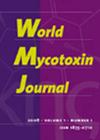Heat-induced reduction of deoxynivalenol and its modified forms during flaking and cooking of oat
IF 1.7
4区 医学
Q3 FOOD SCIENCE & TECHNOLOGY
引用次数: 0
Abstract
Deoxynivalenol (DON) and its modified forms deoxynivalenol-3-glucoside (DON-3G) and 3-acetyl-deoxynivalenol (3-ADON) are common contaminants in Norwegian oats. In order to provide more information about the fate of these mycotoxins during oat processing, the levels of DON, DON-3G, 3-ADON and the sum of them (total DON) were determined using LC-HRMS/MS at different processing steps. Oat groat was softened by either steaming or conditioning, rolled into flakes of two thicknesses, and subsequently cooked to produce flake porridges. Flour of oat groat (untreated or kilned) was cooked to flour porridges. The flaking process had major effect on the mycotoxin levels in resulting flakes, with significant impact for type of softening regime, but not for flake size. Steam-softening caused the largest reduction of DON, DON-3G and total DON in flakes, retaining 41, 60 and 46%, respectively, compared to oat groat. In contrast, 3-ADON in flakes was most reduced by conditioning, to 29% of the levels in oat groat. Cooking to porridge from flakes did not result in any additional mycotoxin reduction, though significant impact of flake size was shown in the final porridges, with highest reduction of total DON in the porridges originating from steamed thick flakes. Cooking porridge from untreated oat flour gave significant reduction in mycotoxin levels, however not for kilned oat flour which had already undergone reduction during kilning. In conclusion, the study shows that processes involving heat-treatment, i.e. kilning, steaming or cooking, efficiently reduced total DON in oats during flaking and porridge cooking, and reduction is dependent on previous processing steps.燕麦剥皮和蒸煮过程中脱氧雪腐烯醇的热诱导还原及其修饰形式
脱氧雪腐镰刀菌醇(DON)及其改性形式脱氧雪腐镰刀菌醇-3-葡萄糖苷(DON- 3g)和3-乙酰-脱氧雪腐镰刀菌醇(3-ADON)是挪威燕麦中常见的污染物。为了进一步了解这些真菌毒素在燕麦加工过程中的命运,采用LC-HRMS/MS测定了不同加工步骤中DON、DON- 3g、3-ADON的水平及其总和(总DON)。燕麦粥通过蒸煮或调理软化,卷成两种厚度的薄片,随后煮成片状粥。燕麦粥的面粉(未经处理或已煮熟)煮成面粉粥。剥落过程对产生的薄片中的霉菌毒素水平有主要影响,对软化制度的类型有显著影响,但对薄片大小没有影响。与燕麦相比,蒸汽软化使薄片中DON、DON- 3g和总DON减少最多,分别保持了41%、60%和46%。相比之下,燕麦片中的3-ADON经调理后减少最多,降至燕麦片中的29%。从薄片煮成粥没有导致任何额外的霉菌毒素减少,尽管在最终的粥中显示了薄片大小的显著影响,在蒸厚薄片的粥中,总DON的减少量最大。用未经处理的燕麦粉煮粥可以显著降低霉菌毒素水平,但对于已经在烘烤过程中进行了还原的燕麦粉则没有。综上所述,该研究表明,在剥皮和煮粥过程中,涉及热处理的工艺,即烧制、蒸或煮,可以有效地减少燕麦中的总DON,并且减少程度取决于先前的加工步骤。
本文章由计算机程序翻译,如有差异,请以英文原文为准。
求助全文
约1分钟内获得全文
求助全文
来源期刊

World Mycotoxin Journal
MYCOLOGY-
CiteScore
4.60
自引率
5.00%
发文量
25
审稿时长
>12 weeks
期刊介绍:
''World Mycotoxin Journal'' is a peer-reviewed scientific journal with only one specific area of focus: the promotion of the science of mycotoxins. The journal contains original research papers and critical reviews in all areas dealing with mycotoxins, together with opinions, a calendar of forthcoming mycotoxin-related events and book reviews. The journal takes a multidisciplinary approach, and it focuses on a broad spectrum of issues, including toxicology, risk assessment, worldwide occurrence, modelling and prediction of toxin formation, genomics, molecular biology for control of mycotoxigenic fungi, pre-and post-harvest prevention and control, sampling, analytical methodology and quality assurance, food technology, economics and regulatory issues. ''World Mycotoxin Journal'' is intended to serve the needs of researchers and professionals from the scientific community and industry, as well as of policy makers and regulators.
 求助内容:
求助内容: 应助结果提醒方式:
应助结果提醒方式:


